If you’re looking for the best studio monitor speakers for editing in 2025, I’ve got you covered. I’ve reviewed top options like PreSonus Eris 3.5, Mackie CR3.5, Yamaha HS3, Edifier R1280T, and M-AUDIO BX3BT, all known for accurate sound, versatile connectivity, and compact design. These monitors suit different budgets and room sizes, ensuring you get precise audio for professional mixes. Keep exploring—there’s more to find that fits your setup perfectly.
Key Takeaways
- Focus on monitors with flat frequency responses for accurate audio editing and mixing.
- Prioritize models with versatile connectivity options like XLR, TRS, and Bluetooth.
- Consider size and design for optimal placement in small or desktop studio setups.
- Look for features such as adjustable tone controls and room correction for tailored sound.
- Evaluate power output and clarity to ensure professional-grade performance in editing environments.
PreSonus Eris 3.5 Studio Monitors (Pair)

If you’re looking for compact, accurate studio monitors that deliver professional-quality sound without taking up too much space, the PreSonus Eris 3.5 are an excellent choice. These powered speakers are perfect for near-field listening, multimedia, gaming, or home studios. They feature a sleek black design and measure about 5.5 x 6 x 8.3 inches, making them easy to place on desks or shelves. Equipped with 3.5-inch woofers and silk-dome tweeters, they produce neutral, detailed sound with a wide stereo image. With 50W of amplification and adjustable EQ controls, they offer customizable sound tailored to your room and preferences.
Best For: home studio creators, multimedia enthusiasts, and casual listeners seeking compact, accurate studio-quality sound.
Pros:
- Compact size fits easily on desks or shelves without occupying much space
- Neutral, detailed sound with a wide stereo image ideal for critical listening and mixing
- Versatile connectivity options including balanced TRS, RCA, and Bluetooth for flexible setup
Cons:
- Included cables may be of mediocre quality, requiring upgrades for optimal performance
- Bluetooth functionality may introduce latency and require manual re-pairing when switching devices
- Limited low-end response without an external subwoofer for bass-heavy music or sound design
Mackie CR3.5 Studio Monitors with Tone Knob and Location Switch
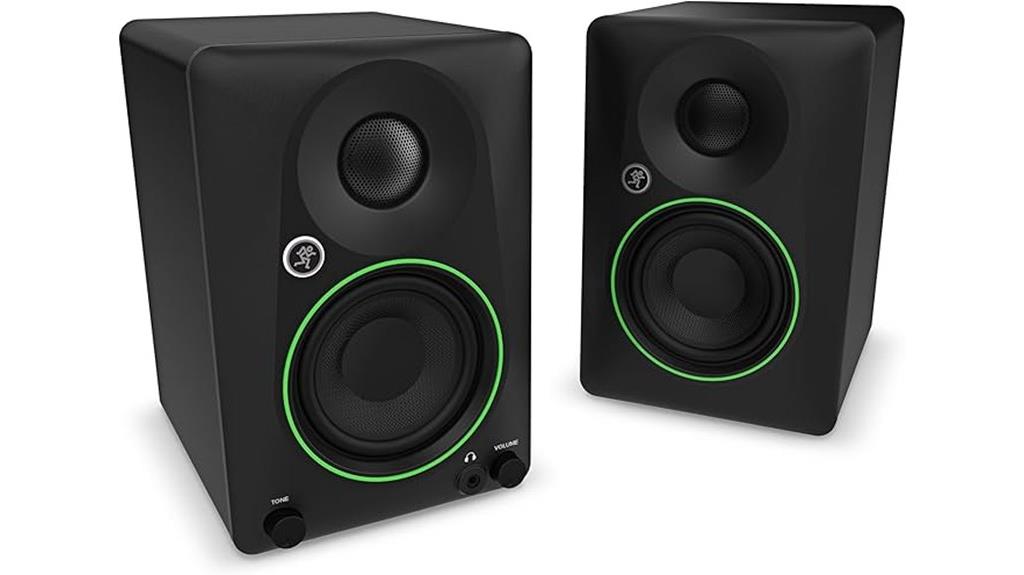
The Mackie CR3.5 Studio Monitors stand out for their versatile tone control knob and switchable placement modes, making them an ideal choice for both beginners and experienced audio enthusiasts. These monitors deliver professional-quality sound with a silk dome tweeter and a 3.5-inch woven woofer, providing clear, balanced audio with strong low-end response. The adjustable tone knob lets you boost bass or add high-end sparkle, tailoring sound to your environment. The switchable modes—desktop and bookshelf—optimize placement for close or distant listening. With multiple input options, Bluetooth, and a headphone output, they’re versatile and user-friendly, perfect for studio work, casual listening, or gaming.
Best For: musicians, content creators, and casual listeners seeking versatile, high-quality studio monitors with customizable sound and placement options.
Pros:
- Versatile tone control knob allows tailored sound to suit different environments and preferences
- Switchable desktop and bookshelf modes optimize placement for close or distant listening
- Multiple input options including Bluetooth, RCA, TRS, and headphone output enhance connectivity and convenience
Cons:
- Possible clipping at maximum volume levels during high-intensity listening
- Bluetooth streaming may have slightly lower audio fidelity compared to wired connections
- Compact size might limit bass response without an external subwoofer for very deep low-end needs
Ortizan C7 Dual-Mode Studio Monitors (Pair, Black)
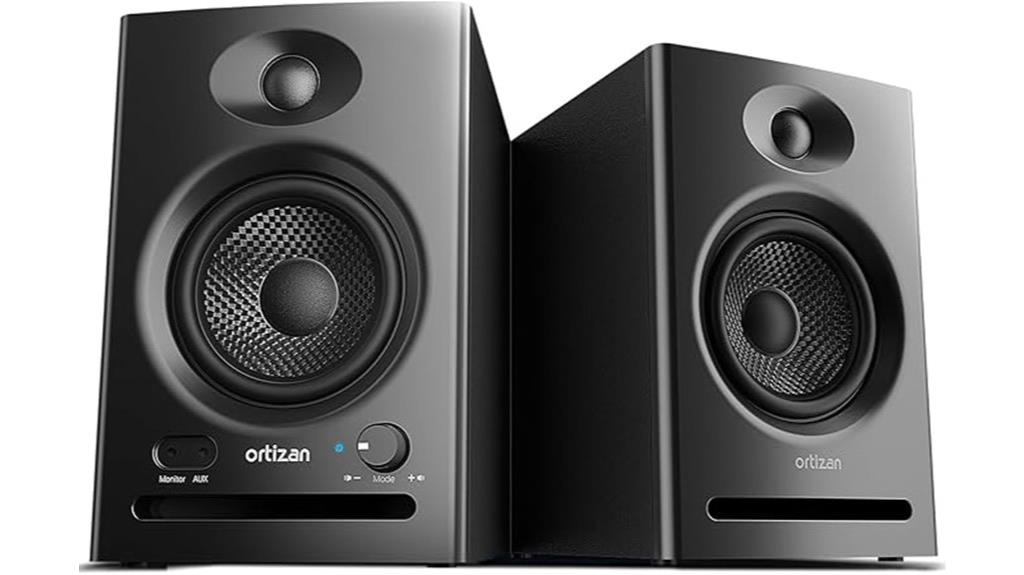
Designed for content creators and audio professionals, the Ortizan C7 Dual-Mode Studio Monitors deliver versatile connectivity and high-fidelity sound in a compact package. They offer multiple inputs, including RCA, 6.35mm TRS, AUX, and Bluetooth 5.3 for effortless wireless pairing. Equipped with a 3.5-inch carbon fiber mid-bass driver and a silk dome tweeter, they produce clear mid-range and crisp highs. The built-in 24-bit DAC ensures accurate digital audio, while the flat response curve guarantees true-to-source sound. With a front headphone jack and flexible wired options, these monitors are perfect for detailed editing, music production, and multimedia use.
Best For: content creators, audio professionals, and audiophiles seeking versatile, high-fidelity studio monitors for mixing, editing, and multimedia applications.
Pros:
- Multiple connectivity options including RCA, TRS, AUX, and Bluetooth 5.3 for seamless wired and wireless use
- High-quality 3.5-inch carbon fiber mid-bass driver and silk dome tweeter deliver clear, detailed sound across all frequencies
- Built-in 24-bit DAC and flat response curve ensure accurate, true-to-source audio reproduction
Cons:
- Compact size may limit deep bass response compared to larger studio monitors
- Requires external power source, not entirely portable for on-the-go use
- May be more expensive than basic speakers lacking professional tuning and multiple input options
Yamaha HS3 Powered Studio Monitor in Black, Pair (HS3 B)

For professionals seeking accurate and versatile studio monitoring, the Yamaha HS3 Powered Studio Monitor in Black, Pair (HS3 B) offers an excellent option. These 2-way bass-reflex speakers feature 3.5-inch woofers and 0.75-inch dome tweeters, delivering a frequency response from 70 Hz to 22 kHz. Each monitor provides 26 W of power, with room control and high trim response adjustments to tailor sound to your space. Connectivity options include XLR/TRS, RCA, and stereo mini jacks, making setup flexible. Included accessories like speaker cables and anti-slip pads ensure stability and ease of use. Overall, they’re designed for precision and clarity in professional studio environments.
Best For: professionals and audio engineers seeking accurate, versatile studio monitors for mixing and production in a professional studio environment.
Pros:
- Accurate sound reproduction across a wide frequency range (70 Hz to 22 kHz) for precise mixing
- Multiple connectivity options (XLR/TRS, RCA, stereo mini jacks) for flexible setup
- Adjustable room control and high trim response for customized sound tuning
Cons:
- Limited bass response due to 3.5-inch woofers, which may require additional subwoofers for full-range sound
- 26 W power per monitor might be insufficient for large or highly demanding studio spaces
- Compact size may not suit those needing larger speakers for broader sound coverage
Edifier R1280T Powered Bookshelf Speakers

If you’re seeking an affordable yet versatile option for accurate listening and editing, the Edifier R1280T powered bookshelf speakers are an excellent choice. They provide 42 Watts RMS power through a 2.0 active near-field design with wooden enclosures, ensuring clear, balanced sound across all frequencies. With dual AUX inputs, you can connect multiple devices simultaneously, and side panel controls let you fine-tune volume, bass, and treble. The included remote makes adjustments effortless. Their classic wood finish complements home decor, and they excel in delivering crisp vocals, detailed guitar breaks, and solid bass—making them perfect for music, gaming, and multimedia editing.
Best For: audiophiles, home office users, and multimedia enthusiasts seeking affordable, versatile, and accurate audio for music, gaming, and editing.
Pros:
- Clear, balanced sound with rich vocals and solid bass across various genres
- Easy to connect via dual AUX inputs, RCA, and Bluetooth with remote control for convenience
- Elegant wooden finish and compact design that complements home decor
Cons:
- Limited bass compared to 2.1 systems with dedicated subwoofers
- Mids and highs may require EQ adjustments to suit individual preferences
- Not waterproof and designed strictly for indoor use
M-AUDIO BX3 Pair 3.5-inch 120W Studio Monitors
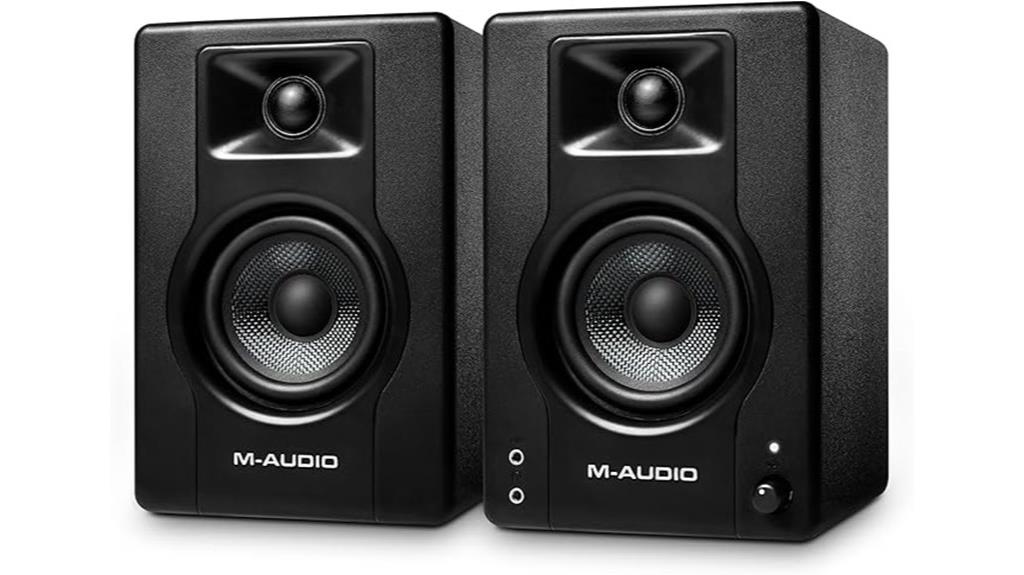
The M-AUDIO BX3 Pair stands out for those seeking versatile, high-quality studio monitors that can handle a variety of audio tasks, from music production to gaming. These 3.5-inch monitors deliver 120W of power, ensuring clear, detailed sound. They feature premium components like Kevlar low-frequency drivers and silk dome tweeters, along with a bass reflex design for deep, rich bass. With multiple input options—1/4”, 1/8”, and RCA—they’re adaptable for studio, desktop, or DJ setups. The included accessories and software make setup easy, making these monitors a practical choice for both casual listeners and professionals aiming for accurate sound reproduction.
Best For: musicians, producers, gamers, and content creators seeking versatile, high-quality studio monitors for accurate sound reproduction across various audio applications.
Pros:
- Delivers 120W of powerful, clear, and detailed sound.
- Features premium components like Kevlar drivers and silk dome tweeters for high-quality audio.
- Multiple input options (1/4”, 1/8”, RCA) for versatile connectivity and setup.
Cons:
- 3.5-inch drivers may have limited bass response compared to larger monitors.
- Requires space and proper positioning for optimal sound imaging.
- Some users might find the lack of additional features like Bluetooth or built-in EQ presets.
OHAYO 60W Computer Speakers for Gaming and Music

With its compact design and versatile connectivity options, the OHAYO 60W Computer Speakers deliver powerful sound perfect for gaming and media playback on desktop setups. The sleek white finish and modern aesthetic make them a stylish addition to any home or office. They feature a space-saving tabletop mount, making setup easy and clutter-free. Equipped with a 0.75-inch carbon fiber silk dome tweeter and a 3-inch full-range driver, they produce crisp highs, rich mids, and satisfying bass. Multiple input options, including Bluetooth 5.3, RCA, AUX, USB, and TRS, guarantee broad compatibility. Overall, these speakers provide impressive sound quality and convenience at an affordable price point.
Best For: users seeking compact, stylish computer speakers with versatile connectivity and quality sound for gaming, music, and media playback in home or office setups.
Pros:
- Compact, modern design that complements contemporary decor and saves space
- Powerful 30W x 2 sound output with clear highs, rich mids, and satisfying bass
- Multiple input options including Bluetooth 5.3, RCA, AUX, USB, and TRS for broad device compatibility
Cons:
- Slightly limited bass compared to dedicated subwoofers due to built-in 3-inch subwoofer
- Cable length and setup can cause minor initial confusion for new users
- Not suitable for very large spaces beyond 50 square meters without additional amplification
YAMAHA Hs5 Powered Studio Monitor, Pair

For those seeking accurate, transparent sound in a compact form, the Yamaha HS5 powered studio monitors stand out as an excellent choice. These 2-way, bi-amplified monitors feature a 5-inch cone woofer and 1-inch dome tweeter, delivering a flat frequency response from 54 Hz to 30 kHz. With 45W for lows and 25W for highs, they provide clear, detailed sound ideal for mixing and mastering. Their sturdy wood construction emphasizes sonic purity without coloration, and their rear-ported design requires proper placement. Easy to connect via XLR or TRS, they’re perfect for small to medium studios, offering high resolution and accuracy at a competitive price.
Best For: Home studio producers, musicians, and audio engineers seeking accurate, transparent sound for mixing, mastering, and casual listening in small to medium spaces.
Pros:
- Excellent accuracy and flat frequency response for true-to-source sound
- Compact and sturdy wood construction with appealing aesthetic design
- Easy to connect via XLR and TRS inputs, suitable for various setups
Cons:
- Tame bass response may require additional subwoofer for bass-heavy genres
- Rear-ported design necessitates proper placement to avoid bass reinforcement issues
- Slightly higher weight and size may be less ideal for very limited spaces
Edifier MR4 Powered Studio Monitor Speakers (Pair)

If you’re looking for a budget-friendly studio monitor that delivers warm, engaging sound, the Edifier MR4 Powered Studio Monitor Speakers are worth considering. These 4-inch active near-field monitors feature a sleek, white bookshelf design with MDF construction to reduce resonance, ensuring true sound reproduction. They offer a near-flat response, producing clear, balanced audio with rich bass and smooth highs, adjustable via accessible bass and treble knobs. Equipped with multiple inputs—including RCA, TRS, and AUX—they’re versatile for various setups. While the LED indicator may fail early, their solid build and immersive soundstage make them ideal for casual listening, multimedia, and semi-professional use.
Best For: casual music listeners, multimedia enthusiasts, and semi-professional audio users seeking warm, engaging sound on a budget.
Pros:
- Delivers warm, balanced, and engaging sound with rich bass and smooth highs
- Sleek, minimalist design with MDF construction reduces resonance for true sound reproduction
- Versatile connectivity options including RCA, TRS, and AUX inputs
Cons:
- LED indicator may fail early, affecting visual status cues
- Slightly subdued treble, requiring EQ adjustments for brighter sound
- Tweeter size is about three-quarters of an inch, less than the claimed 1 inch
Audea Sound Mate Studio Monitor Speaker

The Audea Sound Mate Studio Monitor Speaker stands out as an excellent choice for professionals and serious enthusiasts who demand high-resolution sound in their desktop setup. It features a classic 2-way system with a 5.25” fiberglass midrange/subwoofer and a 1” silk dome tweeter, delivering a frequency response from 20 Hz to 20 kHz. Powered by a 60 RMS watt Class A/B amplifier, it offers clear, low-distortion audio. Connectivity is versatile, with RCA, TRS, and XLR inputs, plus front and rear controls for volume and crossover adjustments. Its compact size and stylish design make it perfect for near-field monitoring, ensuring accurate sound reproduction for editing and mixing.
Best For: audio professionals, music producers, and serious enthusiasts seeking high-resolution, accurate desktop monitoring for mixing and editing.
Pros:
- Offers a wide frequency response (20 Hz – 20 kHz) for detailed sound reproduction
- Versatile connectivity options including RCA, TRS, and XLR inputs
- Compact, stylish design suitable for near-field monitoring setups
Cons:
- 2dB deviation in frequency response may affect ultra-critical mixing precision
- 60 RMS watt amplifier might be limited for very high-volume or large-room use
- No built-in room calibration or advanced DSP features
Mackie CR-X Series 3.5-Inch Multimedia Monitors
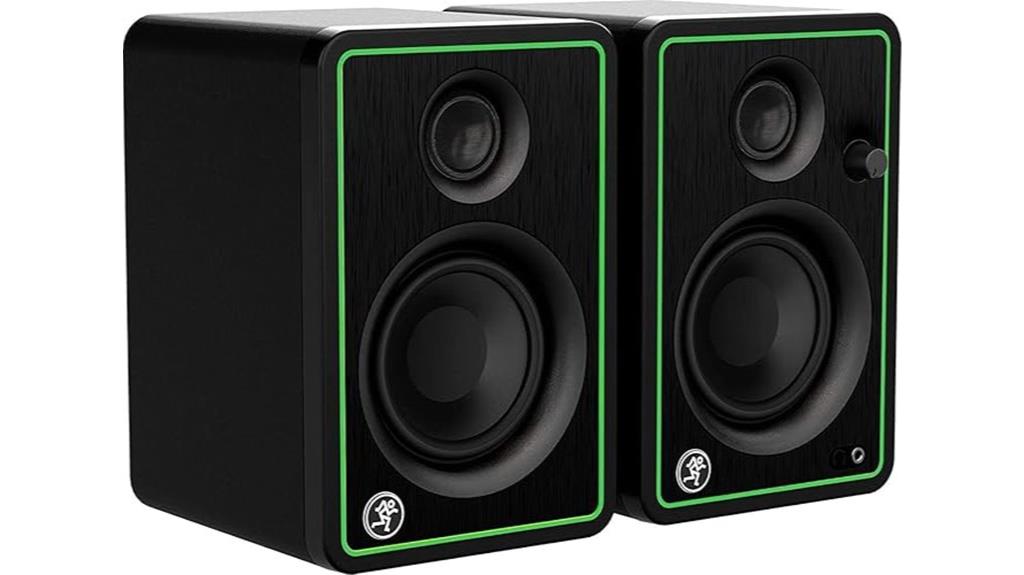
Mackie’s CR-X Series 3.5-Inch Multimedia Monitors stand out as an ideal choice for content creators and beginners seeking studio-quality sound in a compact, stylish package. The CR3-X features a 3-inch woofer, brushed-metal panel, and a tabletop mount, making it perfect for desktops and small spaces. The CR5-XBT adds a 5-inch woofer, silk dome tweeters, and Bluetooth, blending studio-grade audio with wireless convenience. Both models deliver clear, balanced sound with easy-to-use controls like front volume knobs and headphone jacks. They’re versatile for music, gaming, and casual listening, offering excellent value despite minor durability concerns.
Best For: content creators, beginners, and casual listeners seeking compact, studio-quality sound in an affordable and stylish package.
Pros:
- Compact design suitable for small spaces and desktops
- Clear, balanced, high-fidelity audio with versatile connectivity options
- Easy setup with user-friendly controls, including front volume knob and headphone jack
Cons:
- Some users report durability issues and early hardware failures
- Noise gate circuit can cause cutouts at softer volumes
- Higher price point relative to long-term durability and high-end alternatives
SW208 3 Active Bluetooth 5.0 Bookshelf Speakers

For budget-conscious users seeking versatile wireless connectivity and compact design, the SW208 3 Active Bluetooth 5.0 Bookshelf Speakers stand out as an excellent choice. They deliver HiFi sound quality in a sleek, elegant wooden finish that fits well on desks or bookshelves. Equipped with 60W carbon fiber speakers and a built-in 24-bit DAC via USB, they produce warm mids, deep bass, and crisp treble. With Bluetooth 5.0, USB, auxiliary, and wired subwoofer options, they offer flexible connectivity. Users appreciate their clear, distortion-free sound at moderate volumes, though some note limited maximum volume and occasional USB issues. Overall, they’re a solid, affordable multimedia solution.
Best For: budget-conscious users seeking versatile wireless connectivity and compact, stylish bookshelf speakers for casual listening, gaming, or multimedia use.
Pros:
- Delivers HiFi sound quality with warm mids, deep bass, and bright treble in a compact, elegant wooden design
- Supports multiple connectivity options including Bluetooth 5.0, USB with 24-bit DAC, AUX, and wired subwoofer connection
- Provides clear, distortion-free audio at moderate volumes, suitable for various multimedia applications
Cons:
- Limited maximum volume and occasional USB connectivity issues can affect user experience
- Lack of optical or SPDIF inputs and some engineering flaws, such as unclear manual instructions and mode switching difficulties
- Build quality of cables and ports is low-grade, and some users report intermittent connection problems
Active Bookshelf Speakers, 36W RMS, Bluetooth 5.4 Wireless PC Monitors
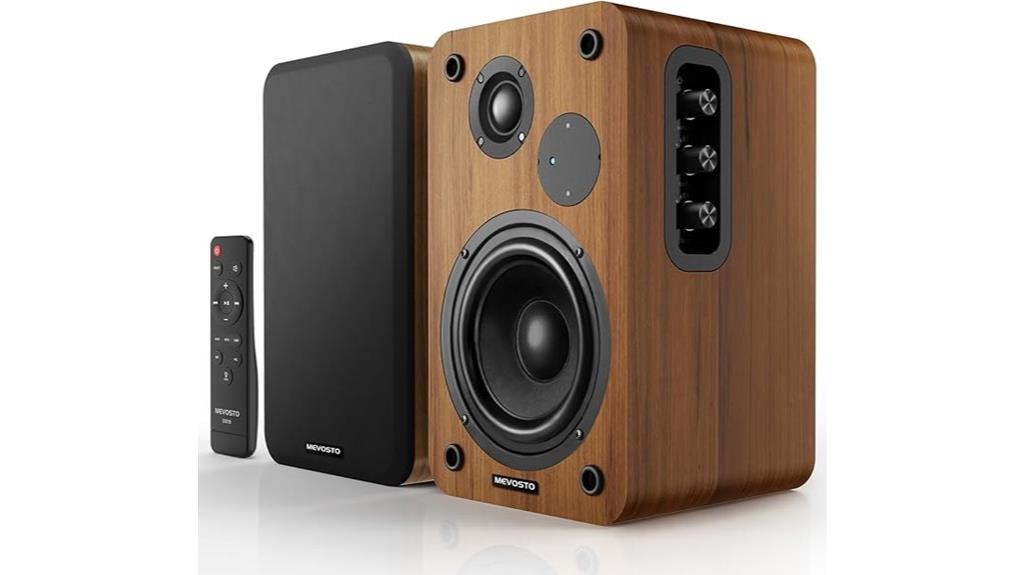
If you’re looking for versatile bookshelf speakers that deliver powerful sound without cluttering your workspace, these 36W RMS Bluetooth 5.4 models are an excellent choice. They produce crisp highs and deep bass with dual 1-inch silk dome tweeters and 5-inch bass speakers, creating rich, immersive audio suitable for gaming, movies, or music. The upgraded Bluetooth 5.4 offers faster pairing, extended range, and low latency, compatible with iPhones, Android devices, and PCs. With multiple wired inputs—including RCA, AUX, and USB—they support various devices like turntables and TVs. The customizable tone controls, natural wood finish, and remote operation make these speakers both practical and stylish.
Best For: users seeking versatile, high-quality bookshelf speakers with powerful sound and flexible connectivity options for gaming, movies, music, and more.
Pros:
- Delivers rich, immersive sound with 36W RMS power and deep bass response
- Upgraded Bluetooth 5.4 ensures fast pairing, extended range, and low latency
- Multiple wired inputs (RCA, AUX, USB) support a wide range of devices including turntables and TVs
Cons:
- Does not support Dolby Audio, which may limit compatibility with some content
- Requires device compatibility with USB audio output to utilize USB connection fully
- Slightly larger footprint due to natural wood finish and speaker design
M-AUDIO BX3BT Studio Monitors with Bluetooth

The M-AUDIO BX3BT studio monitors with Bluetooth stand out as an excellent choice for those seeking versatile, wireless audio options in a compact design. They feature a 3.5-inch Black Kevlar driver and a 1-inch silk dome tweeter, delivering deep bass, clear mids, and crisp highs. With 120W of power and Bluetooth range up to 30.5 meters, you can stream wirelessly from smartphones or laptops. Their straightforward setup includes multiple wired inputs and EQ controls, making them suitable for music production, multimedia, or casual listening. The stylish engineered wood cabinets and space-saving size make them a practical, modern addition to any home studio or entertainment setup.
Best For: music producers, home studio enthusiasts, and multimedia users seeking versatile, wireless, compact studio monitors with high-quality sound.
Pros:
- Wireless Bluetooth streaming with a range of up to 30.5 meters for flexible placement
- Compact, stylish design with durable engineered wood cabinets suitable for various environments
- Powerful 120W output delivering clear, punchy sound with deep bass and crisp highs
Cons:
- Reports of connectivity issues, crackling, or hardware malfunctions out of the box
- Not waterproof or water-resistant, limiting indoor-only use
- Some users find durability or long-term reliability concerns with certain units
Factors to Consider When Choosing Studio Monitor Speakers for Editing
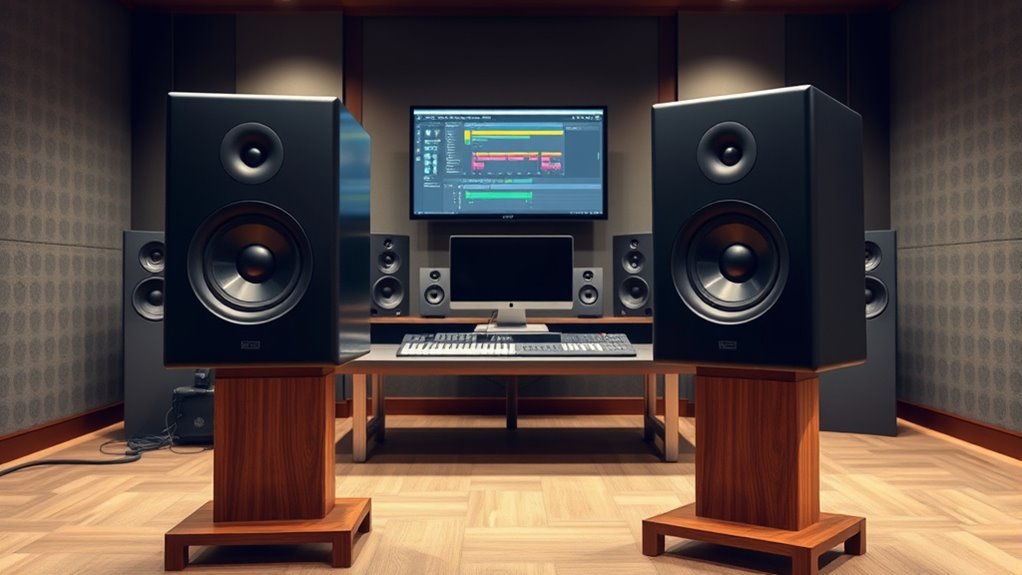
When selecting studio monitor speakers for editing, I focus on sound accuracy and clarity to guarantee my mixes are true to life. I also consider the frequency response range, connectivity options, and whether the speakers suit my room size. Power and volume levels are essential too, so I can work comfortably without distortion or fatigue.
Sound Accuracy and Clarity
Choosing studio monitor speakers with superior sound accuracy and clarity is essential for precise editing and mixing. Accurate reproduction requires a flat frequency response, meaning the monitors shouldn’t boost or cut any part of the audio spectrum. This helps ensure you hear your mix exactly as intended. Clarity depends on minimal distortion and noise, allowing individual instruments and vocals to stand out clearly. High-resolution drivers and well-designed crossovers are crucial for detailed soundstage and precise imaging, so subtle nuances are easily heard. Proper placement and calibration also play a vital role in maintaining sound integrity, preventing room acoustics or positioning from coloring the sound. Ultimately, monitors that reproduce both high and low frequencies clearly enable more reliable editing decisions and a balanced, professional mix.
Frequency Response Range
Sound accuracy and clarity depend heavily on a monitor’s frequency response range, which determines how well it reproduces the full spectrum of audio. A wider range allows monitors to deliver deep bass and sparkling high treble, essential for detailed editing. Monitors that extend below 70 Hz handle low-end sounds more precisely, offering a fuller, more realistic mix. A flat and extended response ensures the sound closely matches the original recording, avoiding coloration or emphasis on specific frequencies. Narrow response ranges can omit or distort audio details, making it harder to make precise editing decisions. When choosing monitors, consider your audio projects—whether you need deep bass for music or high-frequency accuracy for vocals—to guarantee the frequency response aligns with your editing requirements.
Connectivity Options Available
Selecting studio monitor speakers with the right connectivity options is essential for a smooth and flexible editing setup. Most monitors offer various inputs like XLR, TRS, RCA, and 3.5mm auxiliary jacks, allowing you to connect different audio sources easily. Balanced connections such as XLR and TRS are valuable because they reduce noise and interference over long cable runs, ensuring clearer sound. Some speakers also feature wireless options like Bluetooth or USB DACs, making streaming and digital audio input more convenient. Having multiple input choices means you can switch seamlessly between audio interfaces, computers, microphones, and media players without fussing over adapters. Ultimately, the quality and variety of connectivity ports directly affect your setup’s flexibility, compatibility, and overall sound fidelity.
Room Size Compatibility
When picking studio monitor speakers, it’s essential to take into account your room size to guarantee accurate sound reproduction. Larger rooms need monitors with higher wattage and bigger drivers to deliver sufficient volume without distortion. They cover a broader frequency response, typically from 20 Hz to 20 kHz, matching the room’s acoustics. Conversely, small rooms benefit from nearfield monitors with lower power output, helping prevent excessive bass buildup and reducing sound reflections. The size and placement of monitors should align with your room dimensions to optimize stereo imaging and minimize sound anomalies. Additionally, acoustic treatment and precise positioning can enhance sound accuracy, regardless of room size. Properly matching monitors to your space ensures a balanced, clear listening environment essential for quality editing.
Power and Volume Levels
Choosing the right studio monitor involves paying close attention to power and volume levels, as these factors directly affect how well the monitors can fill your room with clear, distortion-free sound. Wattage determines the maximum volume and how loud you can play your tracks without distortion, which is vital for large spaces or detailed editing sessions. It’s important that volume levels are adjustable so you can tailor the sound to your environment and personal preferences, ensuring accurate reproduction at all listening levels. Adequate power prevents clipping during peak moments, maintaining clarity and fidelity. Understanding the relationship between wattage and perceived loudness helps you select monitors that deliver sufficient volume without compromising sound quality, making them ideal for precise editing.
Budget and Value
Budget plays a vital role in determining the quality and features of your studio monitor, so it’s imperative to set a realistic limit based on your specific editing needs. Higher-priced monitors typically offer better accuracy, build quality, and longevity, which are crucial for critical editing tasks. Consider the value provided by features like multiple connectivity options, adjustable controls, and durability, as these can streamline your workflow and ensure long-term satisfaction. Keep in mind that extremely low-cost monitors often sacrifice sound fidelity, frequency response, and durability, which can negatively impact your editing precision. To get the best bang for your buck, compare models based on the cost-to-performance ratio and prioritize well-reviewed options with positive user feedback. This approach helps you invest wisely for accurate, reliable sound monitoring.
Frequently Asked Questions
How Do Studio Monitors Impact Audio Accuracy in Editing?
Studio monitors greatly impact audio accuracy because they deliver a flat, uncolored sound that reveals every detail in your mix. I rely on them to hear true frequency balance and dynamics, ensuring my edits are precise. They help me identify issues like phase problems or muddy tones that might be hidden with consumer speakers. Ultimately, accurate monitors give me confidence that my music will sound great on any playback system.
What Is the Ideal Speaker Size for Small Editing Rooms?
Honestly, in small editing rooms, I’d say 5-inch speakers are your sweet spot. They deliver clear, accurate sound without overwhelming the space or causing bass muddiness. Anything bigger might sound fantastic, but it’s like trying to fit a mansion into a closet. Smaller speakers keep the sound tight and focused, helping you catch every detail without sacrificing clarity. Trust me, size does matter—especially in tight spaces!
How Does Bluetooth Connectivity Affect Sound Quality?
Bluetooth connectivity can slightly impact sound quality because it compresses audio during wireless transmission, which may reduce clarity and detail. However, many modern Bluetooth codecs like aptX or LDAC offer near-lossless quality, minimizing this issue. If you’re serious about audio fidelity, I recommend wired connections for critical editing tasks. But for casual listening or convenience, Bluetooth is a good option without significant compromise.
Are Powered Monitors Better Than Passive Options for Editing?
Imagine a clear, focused beam cutting through fog—that’s what powered monitors do for my editing. I find powered monitors better because they’re all-in-one, offering cleaner sound and less clutter. They’re easier to set up, with built-in amps providing consistent power. Passive monitors need an external amp, adding complexity and potential noise. For precise editing, powered monitors feel more reliable, giving me the clarity I need without extra hassle.
What Safety Precautions Are Recommended for Long-Term Studio Monitor Use?
I always make sure to keep my studio well-ventilated to prevent overheating, as monitors can get warm during long sessions. I also take regular breaks, about every hour, to reduce ear fatigue and avoid hearing damage. Using volume controls carefully is essential—keeping levels moderate protects my hearing over time. Finally, I check my cables and connections frequently to prevent electrical issues that could pose safety risks.
Conclusion
After exploring these options, I believe the best studio monitor depends on your needs and budget. Remarkably, some experts say that even budget monitors can deliver professional-quality sound if you know how to calibrate them properly. So, don’t overlook more affordable models—they might surprise you. Ultimately, trust your ears and choose what feels right. With the right pair, you’ll hear your mixes more clearly, making your editing process much smoother and more accurate.










